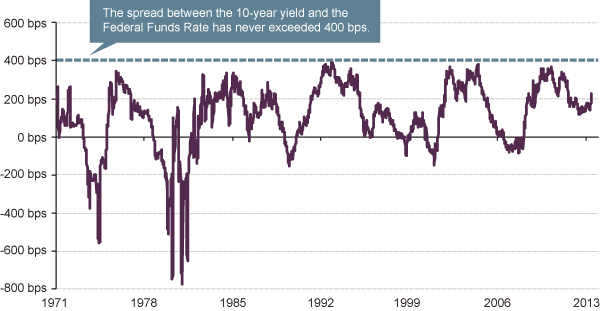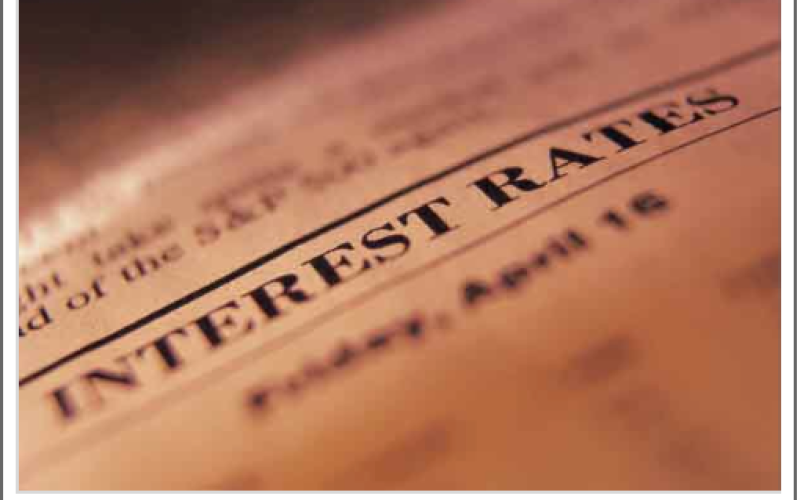A Roadmap for Rates
July 02 2013
Uncertainty over the Federal Reserve’s timeline for tapering quantitative easing has resulted in increased volatility in fixed income markets. While the coming months could see the 10-year Treasury yield climb as high as 3.5 percent, the resulting economic slowdown will keep rates subdued in the medium-term.
by Scott Minerd, CIO, Guggenheim Partners LLC
Recent volatility in the bond market is a direct result of investor reaction to recent statements by U.S. Federal Reserve Chairman Ben Bernanke. The central bank’s stronger-than-expected economic projections and the implications for a faster tapering of quantitative easing caused the recent sell-off in U.S. Treasuries. In the near-term, a number of factors suggest that long-term rates can continue to climb higher. Whether valuing long-term rates by economic fundamentals, technical indicators or a number of other methods, our analysis suggests that the yield on 10-year Treasuries could rise above 3.25 percent by the end of the summer, to as high as 3.50 percent.
These higher rates are likely to be short lived, however. The housing market is already feeling the impact of higher mortgage rates and by August the full effect those rates have on housing affordability will begin to show up in economic data. Given the increasing importance of housing to the overall economic recovery, a drag on housing activity will undoubtedly hold back GDP growth. Once the economy begins to cool, lower interest rates will follow.
Chart of the Week
A Ceiling for 10-Year Treasury Yields
Historically, the spread between the yield on 10-year U.S. Treasuries and the federal funds target rate has never exceeded 400 basis points. As the U.S. Federal Reserve remains committed to keeping the federal funds rate unchanged in the 0-0.25 percent range for a considerable period of time, the current rally in 10-year Treasury yields is unlikely to push beyond 4 percent without a rate hike.
HISTORICAL SPREAD BETWEEN THE 10-YEAR TREASURY YIELD AND THE FEDERAL FUNDS
TARGET RATE

Source: Bloomberg, Guggenheim Investments. Data as of 6/30/2013.
Economic Data Releases
Recent Releases Solid in the U.S.
- The ISM manufacturing PMI was slightly above forecasts in June at 50.9, after dipping below 50 in May.
- University of Michigan consumer confidence in June was revised upward to 84.1, slightly under May’s six-year high of 84.5.
- Personal income rose a better-than-expected 0.5% in May.
- Consumer spending rebounded by 0.3% in May, after falling 0.3% in April.
- The Chicago PMI fell to 51.6 in June from 58.7 last month.
- Initial jobless claims fell by 9,000 to 346,000 for the week ended June 22nd.
- Construction spending in the U.S. increased for a second consecutive month in May, up 0.5%.
- Pending home sales jumped 6.7% in May, the most since April 2010.
Positive Signs in Europe, Outlook Darkens in China
- Economic confidence in the euro zone rose to 91.3 in June, a one-year high.
- The euro zone manufacturing PMI was revised up to 48.8 in June, the slowest pace of contraction since February 2012.
- Retail sales in Germany were up 0.8% in May, the most in four months.
- Unemployment in Germany decreased for the first time in four months in June, falling by 12,000.
- Business confidence in Italy was at a 16-month high in June at 90.2.
- The U.K.’s manufacturing PMI rose to 52.5 in June, a two-year high.
- China’s official manufacturing PMI fell to 50.1 in June, a four-month low, while the HSBC PMI showed a nine-month low of 48.2.
- Industrial production in Japan jumped 2.0% in May, the largest one-month gain since December 2011.
- Japan’s Tankan survey of large manufacturers showed a positive outlook for the first time in two years.
Copyright © Guggenheim Partners LLC














